
de en Home | Books | Posters | 3D-Prints | Art | About
Available here:*
...and as PDF eBook here:
The star signs explained in a more accessible and coherent way than ever, as transformations between the four elements Fire, Air, Water and Earth.
From most elementary properties to deepest themes in psychological astrology, with many references to Greek mythology and examples from daily life, the star signs emerge like reborn with familiar traits.
Suitable for all who know little or nothing about star signs, as well as for professionals, the new approach reveals a much more coherent and easy to learn world of the star signs, which remains nonetheless very multifaceted and multilayered. Hence this book is often almost a revelation even to professionals, allowing them to rediscover well-known themes in more coherently and evidently interwoven ways.
Written and richly illustrated in over 20 pictures by a Swiss physicist (*1966 in Zürich) with lots of experience in astrology and a flair to explain things very accessibly.
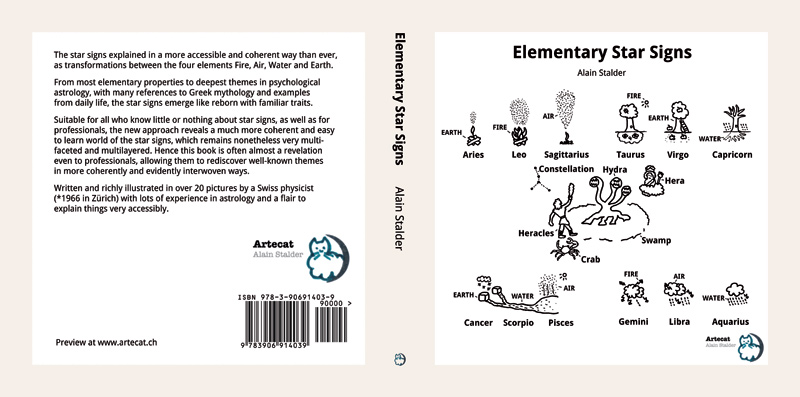

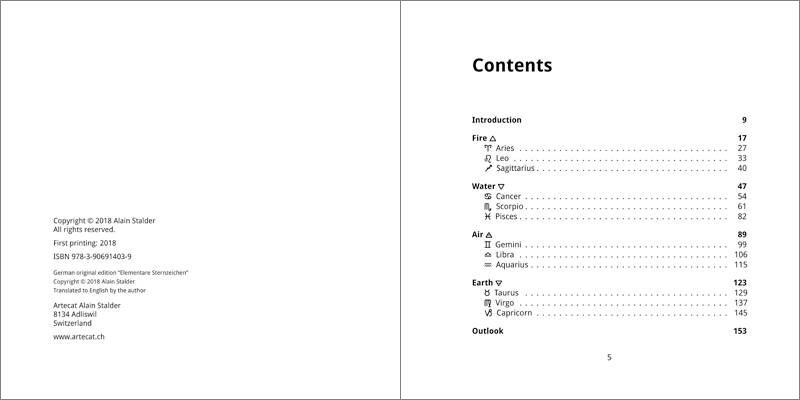

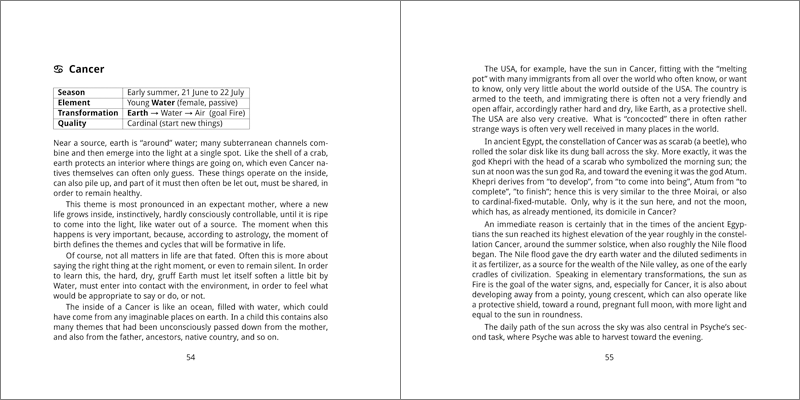

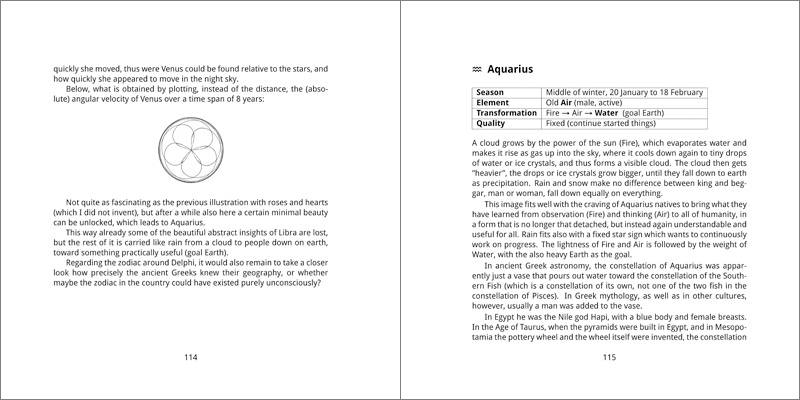
Nowadays, the star signs are often leading the life of a wallflower, which is a pity, because there is so much more depth, richness and diversity in the star signs than generally still conscious to people…
Also, to many modern people it is hardly comprehensible any more how something apparently as archaic as astrology, with so many internal inconsistencies, could still be “true” in the first place.
This is a big topic, which I am approaching here purely from daily experience and literature about the star signs. I am trying to convey as simply, accessibly and fascinatingly as possible how the star signs continue to mirror even today what happens to people and what they strive for—with an astonishingly banal, new approach which allows to rediscover all familiar themes about the star signs, and also reveals new connections and unlocks an inner coherence which could previously only be sensed with plenty of practical experience.
This new approach has—I suspect—roots in antiquity. In particular it had apparently already been mirrored almost 2000 years ago in “The Golden Ass” by Apuleius, more precisely in the famous four tasks that the goddess of love Venus posed to Psyche, the most beautiful woman in the world. The future will show if this can be historically confirmed.
Adliswil, 29 April 2017
Alain Stalder
The twelve star signs of the zodiac are arranged as follows in the year and assigned to the four elements Fire, Earth, Air and Water:
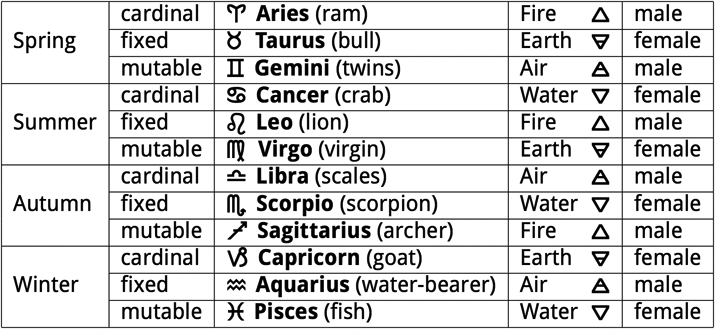
The zodiac starts in spring, with Aries (ram), Taurus (bull) and Gemini (twins). In summer Cancer (crab), Leo (lion) and Virgo (virgin) follow, in autumn Libra (scales), Scorpio (scorpion) and Sagittarius (archer), and finally in winter Capricorn (goat), Aquarius (water-bearer) and Pisces (fish). The first star sign of each season is cardinal, likes to start new things, but does then usually also not stick to what has been started. This is what the following, middle, fixed star signs of each season are good at, and finally the mutable signs refine and complete it.
In addition, star signs are assigned to elements in groups, always in the order Fire–Earth–Air–Water. The star signs and their elements are alternatively considered male (active) and female (passive), thus Aries/Fire male, Taurus/Earth female, Gemini/Air male, Cancer/Water female, Leo/Fire male, and so forth. Thus far, how star signs are usually presented today.
There is, however, an additional, as yet uncharted structure in the star signs, which might still have been known in antiquity:

Learning how to read and apply this table will be pretty much the topic of the rest of this book. What may now maybe appear abstract or banal, is in fact astonishingly deep and diverse, describes the twelve star signs from basic attributes to themes from depth psychology more precisely and coherently than any description to date. Getting immersed into this takes a bit of practice, but pays very quickly with new insights. In that sense, let me rather just start with a concrete example instead of trying to explain the whole table in all generality in advance.
The example is how Cancer, the crab—the youngest Water sign, start of summer, hence cardinal—found its place in the sky as the constellation of Cancer according to Greek mythology.
Heracles (Hercules), the strong Greek hero, son of the father of the gods Zeus, but not of his wife Hera, had to carry out twelve labors, exactly due to Hera's resentment about this. One of the labors was to track down the monster Hydra in the swamps of Lerna and to vanquish it. Doing that was difficult enough, since for every head cut off from the Hydra three or, depending on the version of the myth, even more heads would grow back. But Hera additionally ordered a giant crab to disturb the hero. The crab pinched Heracles' ankles, after which Heracles stomped the crab with his foot, but Hera rewarded the crab after its death by allowing it to continue to live in the sky as a star sign (constellation) for ever, out of gratitude for its obedience.

As Liz Greene clearly shows in “The Astrology of Fate” (Weiser, 1984), in such myths always all protagonists are part of the theme. Hence not only the crab stands for the star sign Cancer, but also Heracles, Hera, the Hydra, the swamp, the fight, the growing back of heads, and so on.
What Liz Greene finds in this myth is the theme of a fight of the son with the mother and the detachment from her, as part of becoming an adult, also as a motivation for a hero who strives for something higher, for fame, be it the one of Heracles or the one of the crab that ascends to heaven. Heracles even means roughly “glory of Hera” in Greek; so he is paradoxically the glory of the very one, the “mother”, who appears to fight him.
Now, how can all of this be explained from a single line in the table?
According to the table, Cancer, as the youngest Water sign, is the first phase in a transformation of the elements from Earth to Water to Air:

The easiest way to picture this is to imagine the three phases of water: ice, water and vapor; thus a block of ice which first melts to water and then evaporates to air. Cancer natives with their hard shells would be like ice, would not yet mix with others, but exactly that, “melting” a little bit, would be their fate/destiny and a mission in life.
This transformation can also be linked to the water cycle. Cancer would be source and creek in the mountains, maybe even out of a glacier, hence out of ice. By mingling with other brooks and rivers, the river grows, gains power, influence; that would be Scorpio. And finally, when the river slows down towards the sea, loses itself in the sea and evaporates due to the fire of the sun in order to complete the water cycle, the apparent power and importance is relativized in Pisces, the last Water sign. See the following illustration, where glaciers are depicted slightly surrealistically as ice cubes:
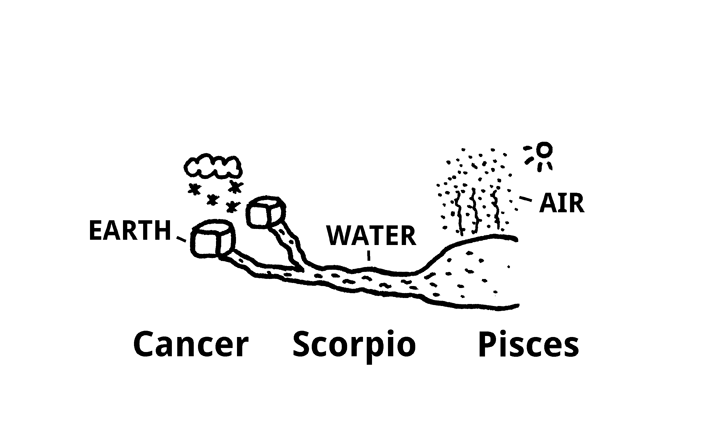
How can this now be related to the myth of Heracles in the swamp? Well, in astonishingly many ways. In the water cycle above, the goal is to rise at the end, by the power of the sun (Fire), hence to ascend into the light (Fire) of public fame. This is why Heracles, as well as the crab, want to rise from the swamp, up to the eternal stars.
By definition, Cancer is in the process of transforming from Earth to Water, and what do you get when you make earth wet? Well, mud or exactly a swamp. Cancer natives must soften their hard shells a little bit, must allow others to come closer, must admit to something, dare something, become “heroes”, in order to develop and fulfill themselves.
So far, this has rather been a male perspective, seen from the son. Seen from the mother, the aim is to nurse and foster the young hero, to protect him from too many influences, to let him “melt” only step by step, on tasks, which he can solve each time, and, yet, are already something special, like the twelve labors of Heracles.
Then again, Hera was not Heracles' physical mother, and she certainly had reason to bear Zeus a grudge for that. Hence her probably somewhat ambivalent attitude towards the “hero in her honor”, which meanders between protectress / promoter and the archaically wild Hydra.
I hope this has been sufficient as an incentive […]. Next, I would like to write a little bit about the elements in general, even if this is maybe not quite as exciting as the previous story, but it helps maybe to understand better why it would be exactly those four elements, and why even today they would still be formative for the fate of human beings.
What is encountered in everyday life is almost always solid, fluid or gaseous, thus “Earth”, “Water” or “Air”, what is nowadays called states of matter in science. Fire or lightning, or other light phenomena, are in that respect the only further “element” that does not fit into the schema solid-liquid-gas in everyday life. Even though additional states of matter are known today, they occur only very rarely in everyday life, again with the exception of “Fire” as plasma in lightning.
All human beings need the elements in order to live and survive: Air to breathe, water to drink, solid food (“Earth”), and energy and warmth (“Fire”). Nowadays this is easily forgotten because the elements are almost always available in the desired quantity: Water from the faucet, food from the fridge or the shop around the corner, protection from wind (Air) by walls, from cold and darkness by heating and electrical light (Fire). For millions of years, however, this had been entirely different. In the past, every day was a new fight for survival, for food, water, protection and warmth, exactly for the elements. But not only a lack of elements was dangerous and traumatic, also their abundance, thus floods, landslides, volcanic eruptions, forest fires and hurricanes.
Something of that sort does not simply disappear after a few millennia of culture and progress. These elementary themes are still very much present in dreams at night, in unconscious fears, wishes and patterns, which shows already in the fact that despite a modern, enlightened life during the day certain themes continue to resurface universally in dreams.
Almost the same can be said about myths and legends. These had been handed down from generation to generation during thousands of years and were only much later written down. What survived was only what was close to the hearts of people in an elementary way, for quite multifaceted and multilayered reasons.
Accordingly, in astrology elements do by far not only refer to the physical world. More precisely, in astrology Earth is the physical word, realistic and immediate, with its hardness and beauty, Water is the world of feelings, relations, music, art, dreams and faith, Air is the world of language, reason and logic, of abstract ideas, models and processes, Fire is the world of fantasy, imagination, initiative, and also of warmth between people.
But more about that shortly, at the start of each chapter about the corresponding element and its three star signs, plus in the last chapter, Outlook, reflected from a few more angles into a short overview. The themes of the star signs are age-old. This makes it impossible to illuminate all themes from all angles, in all nuances, variations, and on all levels, in a single book. But what is realistic—besides, of course, a broad overview with many depths—, is to convey how the new tool of elementary star signs can be used to revisit and rediscover almost everything about the star signs, to find new insights and connections. If I could achieve that, it would make me very happy!
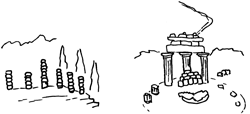
To that end, a tip: Don't read too quickly. Even though things may mostly appear fluid and light, sentences often contain many diverse viewing angles, like a jewel. This makes it often worthwhile to pause a little and to reconsider paragraphs multiple times, always remembering the elements Fire, Air, Water and Earth, and consciously trying to imagine what in each sentence would correspond to which element and what the elementary transformations of the corresponding star sign are. Of course, I often explain exactly this also in the text, but still not over and over again in full detail, also since otherwise reading this book would have quickly become monotonous.
It is also not necessary to understand each and every example; it is more important to let a feeling or an ability to recognize the transformation of the elements emerge almost by itself while reading…
Fire transforms a fuel like wood or coal, thus something earthly (Earth), into smoke and gas (Air). The transformation of the Fire signs would thus be similar to the one of the Water signs, from Earth to Air, only here it would be Fire instead of Water, which transforms Earth to Air:
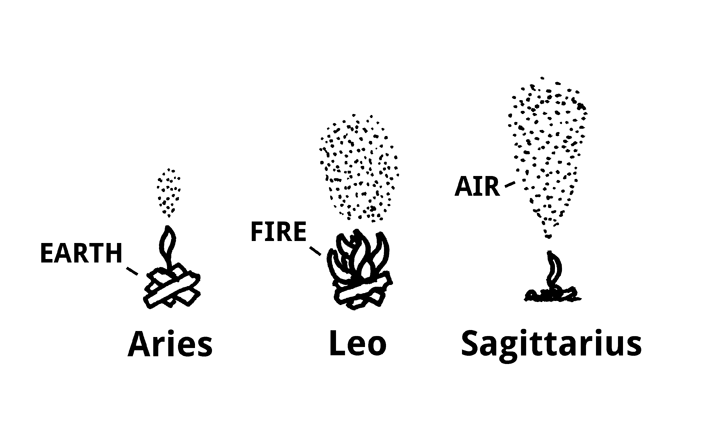
An inclination toward heroism, to rise up into the sky, can also be found in Aries, very similarly to Cancer. However the path up is more obvious for Aries than for Cancer, since the active element Fire rises up out of its own impulse, whereas for Cancer the ice usually has to melt and passively flow down first, before it can finally evaporate and rise.

For Fire signs the transformation can be more painful than for Water signs. What burns in the heat of fire is figuratively the physical body that is consumed by the passion of life and finally dies. In “The Astrology of Fate”, Liz Greene emphasizes the theme of the wound for the two older Fire signs Leo and Sagittarius, with Percival from medieval legends and the centaur Chiron from Greek mythology, respectively, to which I will both come back when exploring the respective Fire signs.
Due or thanks to this wound, Fire signs, at least when getting older, turn often more and more to mental and spiritual activities, to Air and Water. Wise insights about life can be written down or passed on orally; that way they can survive the physical body by a long time – if fellow human beings have become sufficiently attached to preserve them. Speaking in elements, Air, as intellectual creations, already has the potential to become immortal, but only with Water, the love of fellow human beings to these intellectual creations, can this become a reality.
This has already been very roughly the theme of life of Fire signs, while there is still an almost infinite variety of ways for things to play out.
In the following in this chapter, first a very special story regarding the transformation of the Fire signs, then a few thoughts about fire in itself, what properties it has and how they are psychologically mirrored, and finally I will get to each of the individual Fire signs in detail.
The poet Lucius Apuleius lived in the 2nd century CE in today's Algeria, which was also a heyday for astrology. His best known work is “The Golden Ass” in which a traveller, who is also called Lucius, is turned into an ass by a sorceress due to his curiosity and lust, and then lives through many adventures from that perspective, until he finally regains his human form.
The book is, as Robert Graves remarks in the preface of his translation to English, written in the style of a stroller who tells his stories in front of a life audience and always has to keep the audience at it, which is likely why there are so many spicy episodes with liaisons and adultery and the like in the book, but in between also very notable events, especially at the start and end of the book, as well as in the middle of the book, in the “fairy tale” of Psyche and Cupid, the probably best-known part of the book.
This story within the story is told by an aged, half-senile woman, at night in a robber's den in front of the campfire. Not unexpectedly for a book that had been written at the transition between antiquity and the Middle Ages, it still contains elements known from Greek mythology, as well as already ones familiar from fairy tales.
The main characters are from ancient mythology: Venus, the goddess of love, Cupid, her son, and Psyche. But Psyche already reminds a lot of a princess in fairy tales, since she is the youngest of three daughters of a king and the most beautiful woman in the world, almost like Snow White, and yes, she gets her beloved Cupid as a husband at the end and they celebrate their wedding on mount Olympus with all the gods.
But before it comes to that, Psyche must, after several other confusions and an intrigue by her two older sisters, solve four tasks that Venus poses.
Venus would, as Robert Graves remarks, by that time in history have been reduced to almost only an over the top caricature of the love goddess, who is no longer feared as a mighty goddess: When Psyche, desperate and advanced in pregnancy, comes to the house of Venus, Venus, infuriated that she would soon become a grandmother, lets her two maids Sollicitudo (sorrow) and Tristities (grief) rough Psyche up, and then poses her four tasks that are almost impossible to solve, while Venus herself always sneaks away to parties and other amusements.
The four tasks of Psyche fit very well with the transformations of the elements as I describe them in this book. Therefore, I will narrate the story of one task per chapter about the corresponding element…
The third task of Psyche consists of filling a goblet with water from the river Styx until the evening. Now, you have to know that the Styx is the river of the underworld, which flows in a circle, is surrounded by razor-sharp rocks and is guarded by wild monsters. When people curse, they often curse by the names of gods; when gods curse, they curse by the eternal Styx.
Psyche first despairs over the apparently irresolvable task, until the eagle of Jupiter comes to help her, by grabbing the goblet with its claws, flying from above to the middle of the Styx and filling the goblet […].
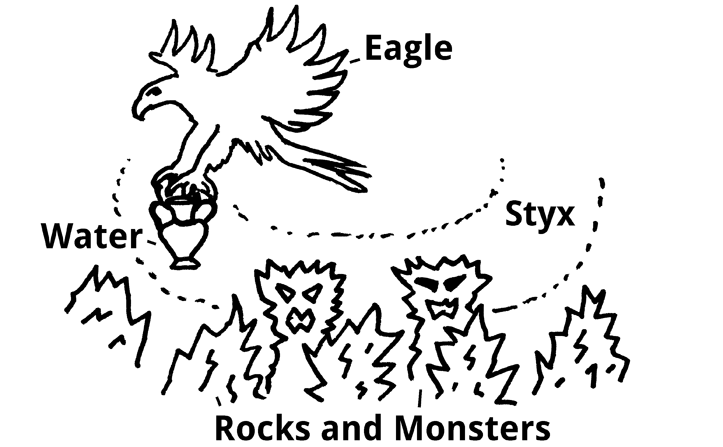
Psyche stands, of course, most immediately for the human psyche, for the inside of human beings. And the fact that she despairs at first over each new task, even usually wants to throw herself from a high cliff or otherwise end her life, and then help comes from somewhere, today you would say from her unconscious, allowing her to master the task, in that lies, I find, a lot of truth about the human psyche.
Fire, the only one of the four elements that can create light, corresponds in the inner world quite a bit to visual imagination, to an inner light, hence to everything that can be visually "painted" inside the mind.
And that is exactly what Psyche did in this task. By gaining an overview of the situation, by rising mentally from the earth below, where there would have been practically no chance of getting through, by using the imaginary power of fire to rise high up into the air, a very simple, elegant solution to the problem was found.
And what she gained that way was exactly the goal of the Fire signs, Water, further emphasized here by the fact that the water originated from the river Styx which flows eternally in a circle; hence what she got immediately symbolized a piece of eternity or even of the immortal soul.
Aid for Psyche came in the form of the eagle of Jupiter, the father of the gods. Now, in astrology the planet Jupiter has its domicile in the third Fire sign, Sagittarius, hence in the very Fire sign that consists almost only of Air any more, which fits again very well with how the task was solved.
In the following, a short overview of the facets of Fire.
This concerns obviously the Fire signs, but also other star signs that contain lots of Fire, like Gemini and Taurus (see table), or the Water signs, for which Fire is missing entirely and is a goal, as well as also all other star signs a bit, especially the ones that lack Fire and then try to find it, for example, in love, in a partner, or also in the wish for a child with lots of Fire.

Fire has two capacities, which no other element has: It can produce light and heat. Mirrored inside, into the psyche, Fire therefore stands for inner light and human warmth, for the power of visual imagination, fantasy and passion.
Visual imagination encompasses a broad spectrum: Architecture and visual arts; imagination, fantasy and visions up to delusions, illusions and projections; careful illumination to make subtle textures visible, in contrast to flood light to emphasize forms and contours, whereby also a lot disappears in the shadow, the world becomes black-and-white; light only sees the surface, not inside, and seeing is only one of the five senses, but a very rich one with colors, forms, and spacial depth and width.
Warmth and heat encompass also quite a few things: Emotional warmth, optimism, creativity, flaming passion and sexual virility, up to a volcano; making something apparently immutable like steel forgeable by focussed heat; burning yourself or others by heat, but also eradicating a center of inflammation by heat; in fairy tales the knightly battle with fire-spitting dragons in order to conquer the favor of a fair maiden; the only creature that can live in fire according to legend, the fire salamander.
Flames can be playfully light and unpredictable, but they also cling very resolutely to their fuel, which can reflect internally also in deep faith and in holding on to ideals and wishes; but there is also fire as more unattached lightning out of clouds, and even rarely as globe lightning; overall electricity resembles fire.
In Plato's famous Cave Allegory, people who are chained up in a cave see only the shadows of objects that are carried around by other people in front of a fire. This bears philosophical depth, especially the one that what can be perceived with the eyes (the “surface”), and overall with all five senses (the “sensory world”), is not necessarily everything that exists in the world.
Before I get to the individual Fire signs in the following sections, I would like to quickly illuminate two aspects of contemporary astrology, which both have a focus on lots of light: Sun signs and sign rulers.
(The paragraphs about these topics are not part of this preview…)

An Aries, who I used to know remotely from work, once said that not the strongest person wins a fight, but the one who, after having been knocked down, stands up most often again. This certainly fits quite a few Aries natives from their point of view, as well as also that the mentioned Aries started to study philosophy at university after retirement, hence directed his interests to something more airy. And many Aries natives would probably have taken on the fight with the razor-sharp rocks and the monsters in the third task of Psyche, and maybe, just like the proverbial ram that repeatedly runs into all obstacles, would have actually found a weak spot.
This neglects, however, that Aries also has a much more subtle nature. Who ever tried to make fire oneself knows that a young flame needs a lot of attention: Enough air by blowing or fanning to keep the flame from going out again, but also not so much air that the flame would be blown out; hence the element Air must be dosed well. And the flame must first be fed with material that burns easily, then gradually with bigger twigs and branches; hence with the element Earth. All in all, this has a lot to do with the female nature of the element Earth out of which the flame grows, whereas the path of Aries is male at first, upward with Fire and Air, even though the long-term goal for Aries, Water, is female again.
Liz Greene writes the following in “The Astrology of Fate”:
The Ram was known to the Egyptians as the primeval god Ammon, or Amun, whose name means “the hidden one”. This antique ram-headed deity was said to be the force behind the invisible wind. He was also called “he who abides in all things”, and was imagined as the soul of all earthly phenomena.
The words she chose fit very well with the elementary transformation: “earthly” for Earth, “force” for Fire, “wind” for Air, and “soul” for Water. There is certainly a very strong phallic, male creative energy connected to Aries, with also more somber, bloody traits. But, other than for the other star sign where Mars has his domicile, Scorpio, where the journey immediately goes down, Aries is aiming to go high, up to the light.
And, yet, Aries often keeps a lot hidden in secret. Like a newborn child, natives of the very first star sign Aries have in their view so little property, knowledge and insight, that they often reveal it only sparingly, thus share little with others and are not very generous. The subsequent Fire sign, Leo, is already a lot more generous and open, if only still quite selective about it, and Sagittarius is then often very much open, while also able to cleverly deviate attention away from the most important secrets.
The contrast between a sensitive earthly nature and an undaunted urge up, towards a better future, is mirrored just as much in Aries women as in Aries men, as will be revealed shortly with Medea and Jason on their quest for the Golden Fleece.
The Golden Fleece was the pelt of a ram that Hera or Zeus had sent in order to save Phrixus and his sister Helle from sacrificial death. Both mounted the ram, which rose up into the air, but Helle got dizzy and fell down into the Hellespont, today the Dardanelles. Phrixus landed safely in Colchis on the east coast of the Black Sea, where he sacrificed the ram to Zeus.
This shows the way up into the air and, connected to it, the need to leave earthly matters behind, symbolized here also by Helle, since she is female like the element Earth. The ram came, like the eagle in Psyche's task, from the air, from Olympus, again from Zeus (Jupiter), or from his wife Hera.
Many years later, the young hero Jason went on a quest for the Golden Fleece, as the leader of the Argonauts, a group of famous heroes, which included also Heracles and Peleus. Aries, as a cardinal sign, is often good as a leader, for example, as the CEO of a company, since a boss often has to take up new things, but then also cannot remain attached to them, must delegate them to coworkers, to remain unbound—from the element Earth—in order to be able to continue to freely seize upcoming opportunities.
Quickly an anecdote, which also emphasizes the close affinity between the two young, cardinal heroic signs Aries and Cancer: The very young hero Jason once carried an old woman across a river and lost a sandal in the course. The old woman turned out to have been Hera in disguise, who thus helped once more to forge the fame of a hero.
Star signs are also assigned to body parts, from Aries to the head down to Pisces to the feet. The fact that Hera made the crab pinch Heracles into his foot and that Jason's sandal also points to his feet shows that Hera also has a lot to do with Pisces, the oldest Water sign, which consists almost only of Air, and, as a Water sign, loves to refresh herself with contact with young heroes. In the past, dead bodies used to be buried on the other side of the river, hence crossing the river also symbolizes the transition from the last star sign, Pisces, into a new cycle, on to Aries.
What guides the young heroes is thus often also a very old woman, who knows all in life. There lies a lot of the apparent chance and astonishing success of the inexperienced heroes, and thus it is also part of Aries itself, and hence of Jason, Medea, Hera, and others in the following myth.
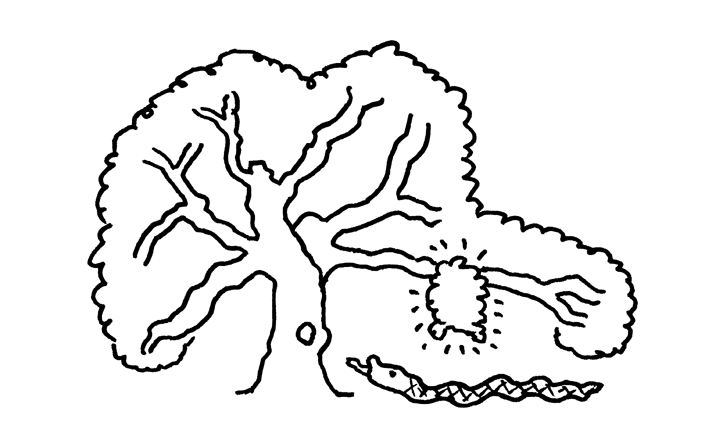
The Golden Fleece was hanging on an oak tree in Colchis in the garden of Ares (Mars), the god of war, who has his astrological domicile in Aries, and the fleece was guarded by a snake that never sleeps. After many, often bloody turns on the journey to Colchis, the gods Zeus, Hera and Athena bribed the love god Cupid to hit Medea with his arrow, so that she fell in love with Jason, who, under a certain pressure, pledged loyalty to her by all Olympic gods, and finally Medea was able to soothe the snake with magic spells so far that the fleece, to which also the spirit of Phrixus was attached, could be taken away.
But Jason and Medea did not stay together forever. After ten years, in which Jason, again only thanks to Medea, had ruled as the king of Corinth, he started to favor another woman, Glauce.
Medea sent her seven sons and seven daughters to Glauce, in order to have them present a white robe and a golden crown to Glauce, apparently to attest Medea's renunciation. But as soon as Glauce put on her presents, they started a fire and burned everyone in the palace, including Medea's children; only Jason could escape, and Medea herself was also not affected. After that Zeus fell in love with Medea; she rejected him and Hera thanked her for that by showing her a way to make the souls of her deceased children immortal. Medea herself never died and entered Elysium, the paradisiacal place in the underworld that is reserved only for the greatest heroes.
Jason has a short memory, which is because he is made of only little Air, so he forgets quickly. This is typical for Aries, and can in small matters also be refreshing, since an Aries is seldom resentful. Medea, however, received, exactly because she had learned not to forget, at least some Water from the gods in the form of her immortality and the souls of her burnt children; their bodies (Earth) had turned into Water via Fire and Air, and children are, after all, usually the result of love, which again corresponds to the element Water.
The morale of this would likely be that Aries natives would really have to detach from the female element Earth in the beginning, but should later also remain loyal and thankful to a found love (Water), let themselves surrender a little bit into a "female nest", let at least go of one sandal?
(Two paragraphs are not part of this preview…)
More about Aries indirectly shortly, in contrast to Leo and other star signs. And why not immediately read up more Greek mythology from Liz Greene as an “exercise”, or read up more about Aries elsewhere, and reinterpret it in an elementary way? Or even secretly pick a hero and navigate him subtly, without him realizing it, into a mythological journey to new knowledge about elementary star signs?
(End of preview)
Page 24 (Fire): "Today, it is known that the earth's axis would not be stable without quite a large moon for a relatively small planet like earth, so life would otherwise in all probability never have had a chance." – This may or may not be true. Recent simulations indicate that the earth's axis might also be relatively stable without a moon, but this is still a matter of active research.
Page 24 (Fire): "However, the Romans originally did not have as rich a mythology as the Greek one, but instead adopted it mainly from the Greeks, by assigning their gods to similar Greek gods." – Page 132 (Taurus): "The Romans later adapted their smith god Vulcan to the Greek Hephaestus, thus sort of forged him into Hephaestus." – This is probably somewhat exaggerated. There were certainly also common roots between ancient Greek and Roman culture, since Greeks already settled in the south of Italy early on; early Greek philosophers like Pythagoras and Empedocles lived there. After the Romans conquered Greece (around 146 BCE), Greek culture got popular in the Roman Empire, at least in an educated upper class, from taking and copying statues and other objects via Ovid's Metamorphoses until emperor Nero's journey through Greece. In ancient Greece planets had names of Greek gods: Mercury was Hermes, Venus Aphrodite, Mars Ares, Jupiter Zeus and Saturn Cronos. Greek mythology incorporates traceably many influences from different regions and cultures. An insight into specifically Roman religion can be found in Cicero's philosophical dialogue "De Natura Deorum" ("On the Nature of the Gods").
Page 80 (Scorpio): "Ancestors of scorpions used to live millions of years ago in the sea as hunters which could attain a length of almost one meter (roughly three feet), and already looked almost like today's scorpions with pincers and sting." – This is exaggerated and most probably wrong in its core. First fossiles of scorpions living on land are dated to 430-390 million years ago; presumably they where then still amphibians. They likely evolved from older species of the order of "Eurypterids", also called "sea scorpions", or of similar orders of animals that lived in the sea. Eurypterids often looked superficially similar to scorpions and some species could attain the size of humans. Apparently, scorpions have a relatively thin chitine shell so that there are not many fossiles of scorpions, which makes it hard to trace their evolution precisely.
Page 133/134 (Taurus): "The European Union (EU) has its roots after World War II, when the victorious powers decided to put stone coal and iron ore under one roof, the European Coal and Steel Community (ECSC), which was founded in 1951 with the sun in Taurus." – Looks like I mixed up something here: The ECSC was founded on 18 April 1951 by the Treaty of Paris, thus with the sun late in Aries and not in Taurus, yet; what was with the sun in Taurus, however, was the Schuman Declaration of 9 May 1950, in which the French foreign minister Robert Schuman first proposed the foundation of the ECSC and thus laid the foundation for a unified Europe.
Available here:*
...and as PDF eBook here:
* Artecat Alain Stalder is thus far not selling books directly to dealers or readers.